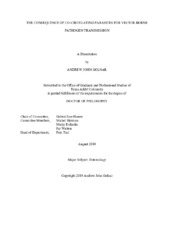| dc.description.abstract | The unprecedented rates of vector-borne pathogen emergence and re-emergence highlights the necessity to identify ecological drivers of transmission heterogeneity. Mosquitoes ingest a variety of viruses, protozoan, and macroparasites that circulate among avian and mammalian hosts. The consequence of these co-circulating parasites for vector-borne pathogen population dynamics remains largely unknown. In this dissertation, field research, controlled laboratory transmission experiments, and mathematical modeling techniques are combined to assess how polyparasitism may influence vector-borne pathogen transmission dynamics. Field techniques used in this dissertation highlight a community of blood-parasites in the Great-tailed grackle (Quiscalus mexicanus), results that document the propensity of co-circulating parasites to influence zoonotic vector-borne pathogen systems. Additionally, two compartmental models that describe the dynamics of vector-borne pathogen transmission structured by host and vector coinfection status were constructed, analyzed, and parameterized in an effort to define a quantitative framework of use for evaluating the impact of polyparasitism on vector-borne pathogen population dynamics. Importantly, results quantitatively illustrate that avian malaria parasites may simultaneously increase and decrease the reproductive number of WNV through multiple mechanisms of interaction.
Finally, numerous experimental transmission assays were completed to evaluate how Plasmodium influence rates of midgut infection and dissemination in mosquitoes simultaneously infected with West Nile and Plasmodium parasites and sequentially infected with Plasmodium and then West Nile virus during a subsequent bloodmeal. Results suggest there are no patterns driving Plasmodium-induced changes in rates of infection and dissemination, suggesting Plasmodium parasites may not be a key driver of natural WNV transmission heterogeneity. Overall, results of this dissertation stress a need to empirically and analytically evaluate the impact of polyparasitism on transmission dynamics as a compounding consequence of multiple ecological and biological mechanisms. Although complex, enhancing our understanding of how patterns of polyparasitism impact zoonotic pathogens can help elucidate novel mechanisms of disease control and surveillance. | en |


